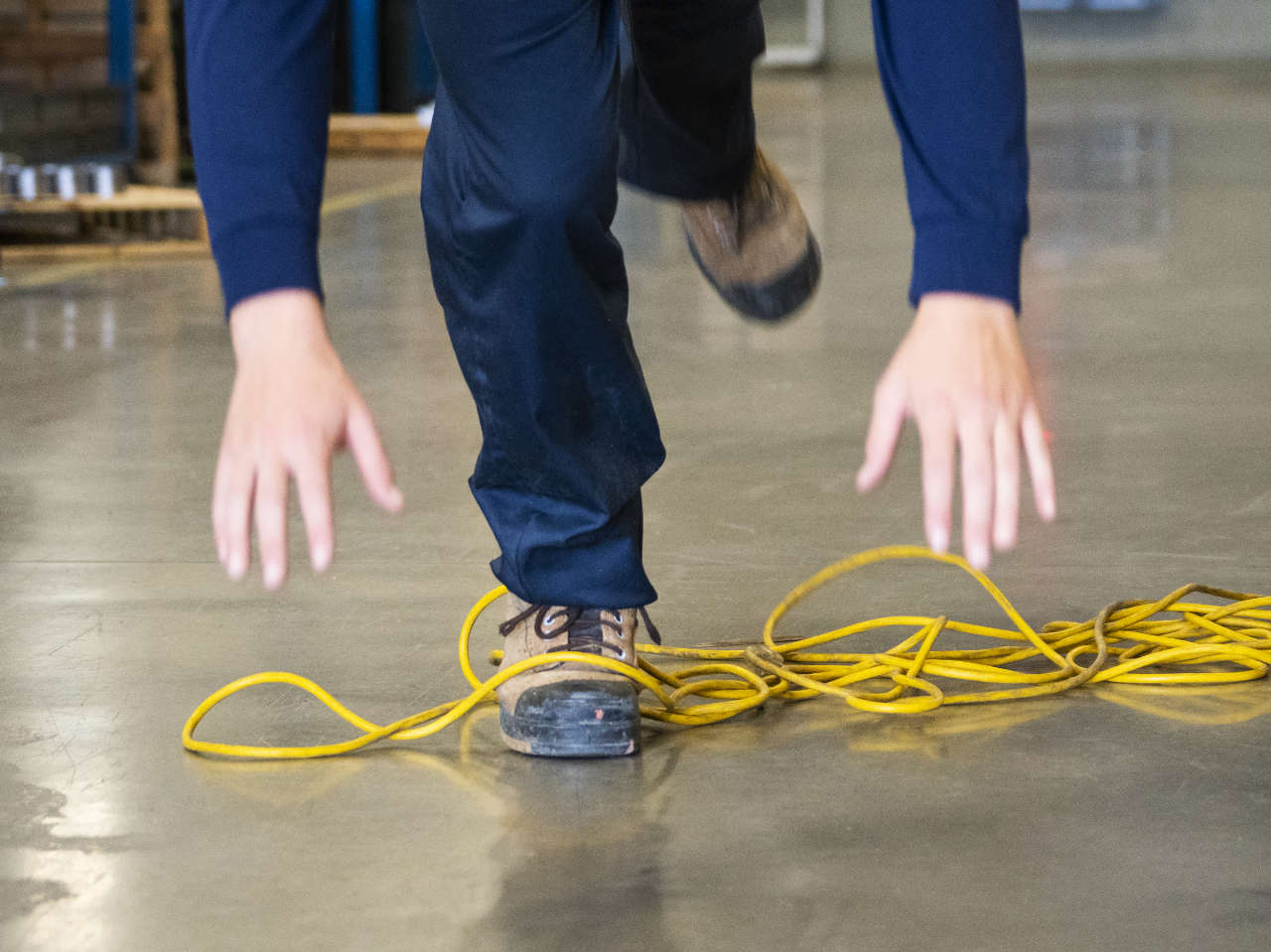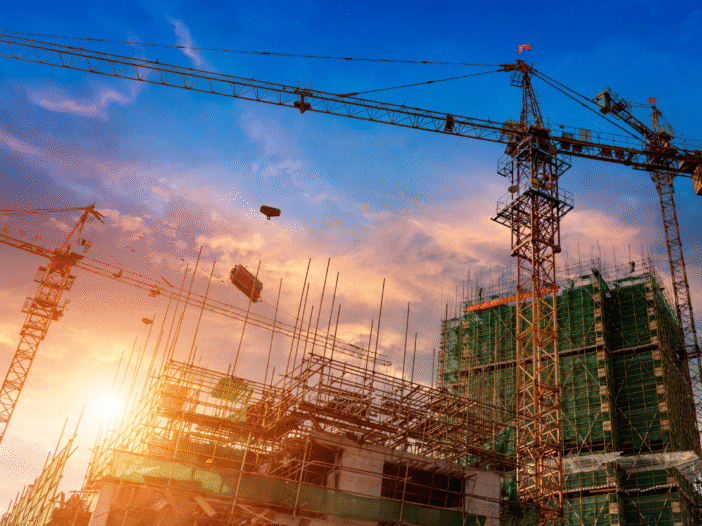
Slips, trips and falls in the workplace resulted in more than 19,000 non-fatal injuries in 2022/23, making up 32% of the total number of injuries reported under RIDDOR.
In 2022/23 35.2 million working days were lost due to workplace injuries, costing the UK economy billions. For employers, work-related accidents can mean a significant reduction in productivity due to sickness absence and lower employee morale.
Although slips, trips and falls statistics are concerning, most accidents are preventable with a commitment to maintaining a safe environment, carrying out regular risk assessments and providing employee training.
What causes slips, trips and falls in the workplace?
A slip happens when there is insufficient friction or traction between your feet and the walking surface, leading to a loss of balance. Slips are caused by slippery flooring, environmental conditions, inappropriate footwear, contamination or obstacles, people and their behaviour, and cleaning routines.
A trip occurs when your foot or lower leg strikes an object, causing your upper body to continue moving and throwing you off balance. Common causes of trips include uneven flooring or terrain, such as worn entrance carpets, sloping pavements, bumps, or dips. Other contributing factors are cables or wires trailing across the floor and poorly maintained steps or flooring tiles.
A fall happens when you are so off-centre that you cannot maintain balance, resulting in parts of your body other than your feet making contact with the ground. Falls can result from poorly protected or defined edges of walkways, inadequate signposting or safety railings near sudden drops, and poorly maintained ladders or stairs.
How to prevent slips, trips and falls in the workplace
1. Practice good housekeeping
Having a comprehensive housekeeping strategy in place is essential for reducing slips, trips and falls in the workplace. This should include planning ahead, having a cleaning schedule, and implementing practices such as mopping up spills immediately and storing items safely.
Regular workplace inspections are an essential control measure to ensure housekeeping is maintained.
2. Keep walking surfaces clean and dry
Ensuring floors and walkways are clean and dry reduces the risk of stumbles and falls.
Regular sweeping and mopping prevent the build-up of dry contaminants such as leaves or dust, which can cause slippages.
Consider installing absorbent mats and umbrella stands in the workplace entrances to help prevent employees and visitors from trailing water or mud in from outside.
For outside walkways, ensure the ground is well maintained, without any cracks or areas for water to pool and that there is sufficient drainage. Ensure surfaces are treated for ice and snow in cold weather and that fallen leaves are removed.
3. Encourage spill management
To effectively reduce the risks of slips, trips, and falls in the workplace, employees must be encouraged and equipped to take proactive measures.
Establish clear reporting procedures and make sure all employees are aware of how to report potential slip, trip, or fall hazards. This could include reporting spills, damaged flooring, or poorly lit areas. Regular reminders in meetings, training sessions, and via workplace signage can help ensure awareness.
Ensure employees have the equipment to deal with hazards immediately and that they know where it is kept. For example, supply easily accessible mops, absorbent materials, and signage to mark wet areas.
Encourage employees to clean up minor spillages themselves if it is safe to do so and to report larger issues promptly to maintenance or cleaning staff.
4. Keep walkways free from obstructions
Obstructions such as personal belongings, crates, boxes or rubbish on the floor are trip hazards.
Install lockers or a cloakroom area for employees to put their personal belongings such as bags, coats and shopping, so they are stored out of the way. Ensure deliveries are put away immediately rather than left in shared areas and encourage safe work practices such as tucking in chairs and closing storage drawers.
5. Maintain office flooring
Whether carpet, tiles or laminate, poorly maintained flooring can create uneven surfaces.
Fix carpet securely to avoid sliding and check for air bubbles or rucked up corners which could cause an employee or visitor to lose their footing. Tiles should be completely secure, and properly grouted and any missing pieces replaced immediately. Maintain other types of flooring, such as laminate, and ensure it is level without any buckling.
Signpost transitions from one flooring type or level to another to avoid trips.
6. Keep power cables tidy
Keep cables from desk phones, computers, routers and printers, lighting, power tools and cleaning equipment tidy. If cables trail across the floor, they could cause someone to trip, so keep wires routed away from walkways.
A common reason for stretching cables across the floor is to reach a power supply, often coupled with extension leads. Ensure your workspace has adequate electrical sockets for the number of employees and install these power points in easily accessible areas, such as next to workstations or through desk level trunking or overhead.
You could also run cables to permanent devices behind walls or under flooring. Invest in a cable management system as a cost-effective way to reduce or eliminate trailing cables.
7. Install and maintain adequate lighting
Poorly lit workspaces, especially in outside walkways, stairways and corridors, are one of the most common causes of slips, trips and falls in the workplace, so check that walkways are illuminated sufficiently.
The Health and Safety Executive (HSE) specifies that lighting should be suitable for both the environment and task. It also highlights that stroboscopic effects or flickers should not be present and that adjacent areas should have similar lighting levels to avoid extreme contrast while moving from one area to another.
Make sure that you use similar bulbs throughout the workspace and consider adding spotlights to enclosed areas such as cellars. The HSE recommends a minimum illuminance of 100 lux for offices and 200 lux for industries requiring the perception of fine detail, such as factories assembling electronic components.
More light may be required at floor level so that employees and visitors are able to move around safely. A lighting survey is a good idea to ensure that all the requirements are covered at different times of the day.
Remember that emergency lighting must be provided and maintained.
8. Enforce appropriate workplace footwear
Unsuitable footwear is a direct cause of slips, trips and falls, so it is vital that employees wear the correct footwear for their environment and that the employer assesses and ensures that the right footwear is specified.
The most appropriate footwear depends on the task. Some outdoor roles may require work boots with thick soles and deep treads, while indoor roles may require a lighter step, so plimsolls with smoother soles may be a requirement.
9. Trip-proof your stairways
Stairs are a common area for slips, trips and falls in the workplace. Ensure each step is well maintained, of uniform height and without chips or damage. Firmly fix carpet or coverings on the stairs and highlight the top and bottom steps with reflective paint or tape where appropriate.
Installing handrails at the correct height will also reduce the risk and consequences of trips and falls.
10. Signage
Calling employees’ attention to potential hazards can help avoid accidents, for example having signs to indicate a change of flooring, ramps ahead or wet floors during cleaning.
11. Conduct regular risk assessments
Risk assessments are vital for preventing slips, trips, and falls by facilitating the identification of potential hazards and implementation of effective control measures.
Employers should assess all areas of the workplace to pinpoint risks such as slippery surfaces, uneven flooring, or trailing cables. The findings of these assessments should be used to prioritise improvements, such as repairing damaged flooring, increasing lighting levels, or installing anti-slip mats.
Regularly reviewing a slips, trips and falls risk assessment ensures that new hazards are identified and addressed promptly. Involving employees in the process, by encouraging them to report hazards and provide feedback, helps to create a safer and more collaborative working environment.
12. Provide slips, trips and falls safety training
Developed by experienced health and safety consultants, our IOSH Approved Slips Trips and Falls Training supports your organisation to comply with the Health and Safety at Work Regulations 1999 and The Workplace (Health, Safety and Welfare) Regulations 1992 by ensuring employees have a thorough understanding of slips, trips and falls hazards in the workplace.
Find out more about Slips, Trips and Falls Training on our website, or contact our friendly team for more information on 0203 011 4242 or info@praxis42.com

Adam Clarke
Managing Director (Consulting)
